Panasonic EWBW30S, EW-BW30 User Manual
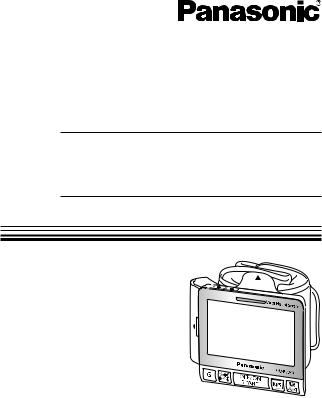
Operating Instructions
Instrucciones de Uso
Wrist Blood Pressure Monitor
Monitor de presión arterial de muñeca
Model No./Nº de Modelo EW-BW30
English |
1 |
Español |
S1 |
Before operating this device, please read these instructions completely and save this manual for future use.
Antes de utilizar este dispositivo, lea completamente estas instrucciones y conserve este manual para futura referencia.

Panasonic Oscillometric Diagnostec™ Automatic Wrist Blood Pressure Monitor Model EW-BW30 is a device intended to measure systolic and diastolic blood pressure and pulse rate of an adult individual by using a pressurized cuff on the wrist. The device is not intended for use on neonatal, infants and children. The device is designed for home use only, not for ambulatory measurement (measurement recorded continuously during the day).
Specifications of this device are listed in page 31.
Blood pressure measurements determined with this device are equivalent to those obtained by a trained observer using the cuff/ stethoscope auscultation method, within the limits prescribed by the American National Standard, Manual, Electronic or automated sphygmomanometers.
If you suffer from disorder of heart rhythm, known as arrhythmia only use this blood pressure monitor in consultation with your doctor. In certain cases oscillometric measurement method can produce incorrect readings.
Flashing System for hypertensive readings are based on blood pressure values classified in the paper: “JNC 7 Express; The Seventh Report of the Joint National Committee on Prevention, Detection, Evaluation and Treatment of High Blood Pressure; U.S. DEPARTMENT OF HEALTH AND HUMAN SERVICES; National Institute of Health; National Heart, Lung, and Blood Institute; National High Blood
Pressure Education Program; NIH Publication No. 03-5233; May 2003.” The display values are generally known, but not proven, to be an indicator of your blood pressure.
The EW-BW30 is not intended to be used as a diagnostic device. Contact your physician if prehypertensive or hypertensive values are indicated.
English


 Table of Contents
Table of Contents
Introduction .............................................................................................. |
3 |
Basics of Blood Pressure ......................................................................... |
3 |
Important Instructions Before Use ........................................................... |
4 |
Precautions to Ensure Safe, Reliable Operation ...................................... |
6 |
Easily Check Your Blood Pressure Readings Against |
|
the JNC 7* Classification .......................................................................... |
7 |
Diagram of the Device .............................................................................. |
8 |
Inserting/Replacing Batteries ................................................................... |
9 |
Setting the Time and Date......................................................................... |
10 |
Fitting the Pressure Cuff .......................................................................... |
12 |
Obtaining Accurate Measurements .......................................................... |
14 |
Wrist Height Sensor.................................................................................. |
16 |
Measuring Your Blood Pressure ............................................................... |
19 |
Movement Detection Function .................................................................. |
24 |
Irregular Pulse Function ........................................................................... |
25 |
Saving and Recalling Data ....................................................................... |
26 |
Comparing AM and PM Average Blood Pressure..................................... |
29 |
After Use .................................................................................................. |
30 |
Specifications ........................................................................................... |
31 |
Explanation of Rating Plate Symbols........................................................ |
31 |
Care and Maintenance ............................................................................. |
32 |
Troubleshooting ........................................................................................ |
33 |
English


 Introduction
Introduction
Thank you for purchasing the Panasonic Automatic Wrist Blood Pressure
Monitor EW-BW30.
Measuring your own blood pressure is an important way of monitoring your health. High blood pressure (hypertension) is a major health problem which can be treated effectively once detected. Measuring your blood pressure between doctor visits on a regular basis in the comfort of your home, and keeping a record of the measurements, will help you monitor any significant changes in your blood pressure. Keeping an accurate record of your blood pressure will help your doctor diagnose and possibly prevent any health problems in the future.

 Basics of Blood Pressure
Basics of Blood Pressure
Your heart acts like a pump, sending blood surging through your blood vessels each time it contracts. Blood pressure is the pressure exerted by blood pumped from the heart on the walls of blood vessels. Systolic pressure is the pressure exerted when the heart contracts and pumps blood into the arteries. Diastolic pressure is the pressure exerted when the heart expands, or relaxes. When you or your doctor take your blood
pressure, both your systolic and diastolic pressures are measured. If your blood pressure measurement is 120 mmHg over 80 mmHg (120/80), for example, your systolic pressure is 120 mmHg while your diastolic pressure is 80 mmHg.
English


 Important Instructions Before Use
Important Instructions Before Use
1.Do not confuse self-monitoring with self-diagnosis. Blood pressure measurements should only be interpreted by a health care professional who is familiar with your medical history.
2.If you are taking medication, consult with your physician to determine the most appropriate time to measure your blood pressure. NEVER change a prescribed medication without first consulting with your physician.
3.For persons with irregular or unstable circulation resulting from diabetes, liver disease, arteriosclerosis or other medical conditions, there may be variations in blood pressure values measured at the wrist versus at the upper arm. Monitoring the trends in your blood pressure taken at either the arm or the wrist is nevertheless useful and important.
4.Blood pressure can vary based on many factors, including age, gender, weight and physical condition. In general, a person’s blood pressure is lower during sleep and higher when he or she is active. Blood pressure can change easily in response to physiological changes. The setting in which a person’s blood pressure is measured can also affect the results.
Having one’s blood pressure measured by a healthcare professional in a hospital or clinic can cause nervousness and may result in a temporarily elevated reading. Because blood pressure measurements taken in a clinical setting can vary considerably from those taken at home, a person’s blood pressure should be measured not only occasionally in the doctor’s office, but also on a regular basis at home. Also, if you find that your blood pressure is lower at home, this is not unusual. To accurately compare with your physician’s reading, take your Panasonic blood pressure monitor to your doctor’s office and compare readings in this setting.
5.People suffering from cardiac arrhythmia, vascular constriction, liver disorders or diabetes, people with cardiac pacemakers or a weak pulse, and women who are pregnant should consult their physician before measuring their blood pressure themselves. Different values may be obtained due to their condition.
6.Try to take your blood pressure measurements at the same time and under the same conditions every day.
•The ideal time to measure your blood pressure (to obtain your socalled “base blood pressure”) is in the morning just after waking up, before having breakfast and before any major activity or exercise. If
English

this is not possible, however, try to take measurements at a specified time prior to breakfast, and before you have become active. You should relax for about 5 minutes before taking the measurement. The following situations may cause substantial variations in blood pressure readings and should therefore be avoided at least
30 minutes prior to taking your blood pressure. Blood pressure will be higher than usual:
-when you are excited or tense
-when you are taking a bath
-during exercising or soon after exercising
-when it is cold
-within one hour after eating
-after drinking coffee, tea or other beverages containing caffeine
-after smoking tobacco
-when your bladder is full
-when in a moving vehicle
Blood pressure will be lower than usual:
-after taking a bath
-after drinking alcohol
7.Measurements may be impaired if this unit is used near a television, microwave oven, X-ray equipment or other devices with strong electrical fields. To prevent such interference, use the unit at a sufficient distance from such devices or turn the devices off.
8.This unit is designed for use by adults. Consult with your physician before using this unit on a child. Do not use on neonatal, infants and children.
9.This unit is not suitable for continuous monitoring during medical emergencies or operations.
10.Do not use the unit for any purpose other than measuring blood pressure. Do not use the unit together with other devices.
11.Improper handling of batteries may result in battery rupture or in corrosion from battery leakage. Please observe the following to ensure proper use of batteries.
a.Be sure to turn off the power after use.
b.Do not mix different types or sizes of batteries.
c.Change all batteries at the same time. Do not mix old and new batteries.
d.Be sure to insert batteries with correct polarity, as instructed.
e.Remove batteries when they are worn out, and dispose of them properly according to all applicable environmental regulations.
f.Do not disassemble batteries or throw them into a fire.
English

g.Do not short-circuit batteries.
h.Do not attempt to recharge the batteries included with the unit.
12.Please remove the cuff if abnormal operation, such as prolonged overinflation, is observed.
Differences in Blood Pressure Values Measured at the Wrist Versus at the Upper Arm
For persons with peripheral circulatory disorders* resulting from diabetes, liver or kidney disease, arteriosclerosis or hypertension, etc., there may be variations in blood pressure values measured at the wrist versus at the upper arm.
Therefore, always consult with a health professional rather than attempting to interpret blood pressure measurements yourself.
*Persons with underlying medical conditions with bad circulation in their hands and feet.

 Precautions to Ensure Safe, Reliable Operation
Precautions to Ensure Safe, Reliable Operation
1.Do not drop the unit. Protect it from sudden jars or shocks.
2.Do not insert foreign objects into any openings.
3.Do not attempt to disassemble the unit.
4.Do not crush the pressure cuff.
5.If the unit has been stored at temperatures below 32 °F (0 °C), leave it in a warm place for about 15 minutes before using it. Otherwise, the cuff may not inflate properly.
6.Do not store the unit in direct sunlight, high humidity or dust.
English
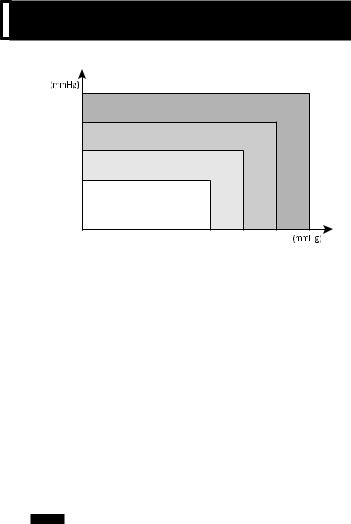
Easily Check Your Blood Pressure Readings Against the JNC 7* Classification
Blood Pressure Categories
(DBP) |
|
Stage 2 Hypertension |
e.g.: SBP 165 |
|
|
Pressure |
100 |
|
|
DBP 105 |
|
Stage 1 Hypertension |
e.g.: SBP 150 |
|
|||
90 |
|
|
DBP 95 |
|
|
|
|
|
|
||
Blood |
Prehypertension e.g.: SBP 130 |
|
|||
80 |
DBP 85 |
|
|||
Normal e.g.:SBP 115 |
|
|
|
||
Diastolic |
|
DBP 75 |
|
|
|
|
|
|
|
|
|
|
|
|
120 |
140 |
160 |
Systolic Blood Pressure (SBP)
If the two blood pressure measurements (systolic, diastolic) fall into separate categories, your level is classified in the higher of the two categories. For example, a Stage 2 systolic reading, but a diastolic pressure reading in the normal range.
*JNC 7: The Seventh Report of the Joint National Committee on Prevention, Detection, Evaluation and Treatment of High Blood Pressure National Institute of Health (NIH) Publication; No. 03-5233, May 2003
IMPORTANT:
•Do not be alarmed by temporarily high or low readings because fluctuations in a person’s blood pressure are not uncommon. If possible, measure and record your blood pressure at the same time every day, and consult your physician if you have questions or concerns.
•If abnormal variations in blood pressure are observed in measurement, please consult your physician.
English
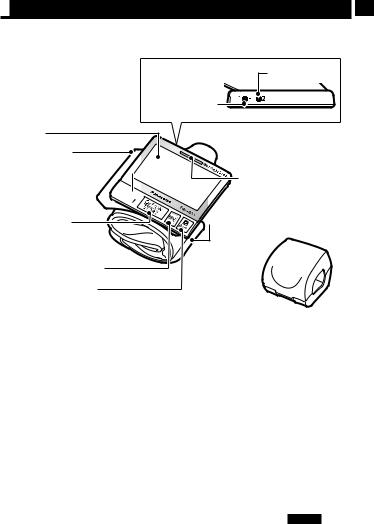

 Diagram of the Device
Diagram of the Device
* Only use alkaline batteries.
Body
View from Top |
Adjust button |
Set button |
Display
Battery cover
Wrist height button 
Graph button 



Off/On Start |
button |

 Positioning mark
Positioning mark
Wrist height sensor lamp
 Pressure cuff
Pressure cuff
Memory/Recall button |
|
AM/PM comparison |
|
button |
Storage case |
|
Can also be used as an armrest. |
This product includes:
•Main unit
•Storage case
•Batteries
•Operating Instructions
•Guarantee card
*Specifications of the product or parts may be changed without prior notice.
English
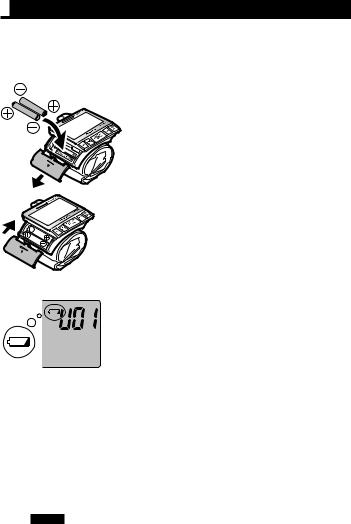

 Inserting/Replacing Batteries
Inserting/Replacing Batteries
*Always use alkaline batteries. (2 AAA-size LR03 alkaline batteries)
•When replacing batteries, always use 2 fresh alkaline batteries of the same type from the same manufacturer, and replace them simultaneously.
1. Remove the device from the storage case.
Insert the batteries.
(1) Slide the battery cover open as shown in the diagram.
(2) Insert the two batteries making sure that they are aligned correctly (+/–).
2. Slide the battery cover shut until it clicks.
Replace batteries when:
• The “low battery” indicator is displayed.
• No display appears even if the Off/On Start button is pressed.
CAUTION:
•Always follow the cautions printed on the batteries.
•Check the polarities of the batteries and install them correctly.
•Remove exhausted batteries promptly.
•If the product will not be used for a long time, remove the batteries.
•Batteries should be used before their expiration date.
Use after the expiration date may result in injury or staining of the surrounding area due to generation of heat, bursting, or leakage.
English
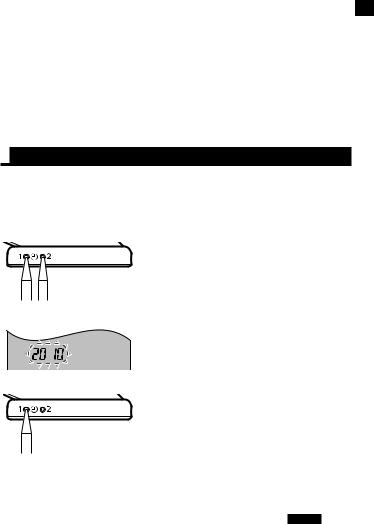
For Batteries
• The frequency of use for batteries is approximately 300 measurements (3 times per day) with fresh Panasonic alkaline batteries (AAA-size LR03 alkaline batteries). [Measurement conditions: Room temperature 73.4 °F (23 °C); Pressurized to 170 mmHg; Wrist circumference: 6-3/4˝ (17 cm)]
•If batteries other than alkaline batteries are used or batteries are used in a cold room, and when measuring a person with high blood pressure, battery life may be dramatically shorter.
*Use alkaline batteries. (Panasonic Oxyride batteries can also be used.)
•Be sure to replace batteries once a year to prevent battery leakage.

 Setting the Time and Date
Setting the Time and Date
*Having inserted the batteries, set the time and date so that any future stored measurements are saved in the memory with the correct time and date.
(If you attempt to take measurements without first setting the time and
date then “—” will be displayed.)
1 Press and hold the Set button “1” on
the top side of the unit.
• Set the “year”.
1 2
Set Adjust
“Year”
2Press the Adjust button “2” to adjust the number.
•Each press of the button raises the number of the “year”.
•Setting range for years is from 2010 to 2050.
3Press the Set button “1” to fix the number.
•The “year” will be fixed. Then, set the “month”.
3
Fix
English 10
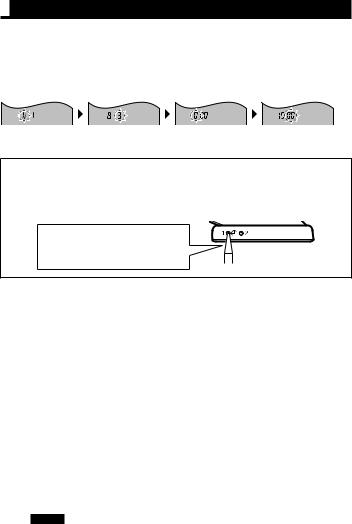

 Setting the Time and Date (cont.)
Setting the Time and Date (cont.)
4Adjust in order of “month”, “day”, “hour”, and “minutes”, repeating steps 2 and 3.
•The clock is stopped while the date or time is flashing.
“Month” |
“Day” |
“Hour” |
“Minute” |
5Press the Off/On Start button to turn off the unit.
Note) During the setting if the Off/On Start button is pressed, or if no button is pressed for 5 minutes, the settings made up to that point will be used.
* Setting range for years is from 2010 to 2050.
Use the tip of a ballpoint pen etc. to press the Set and Adjust buttons.
11 English
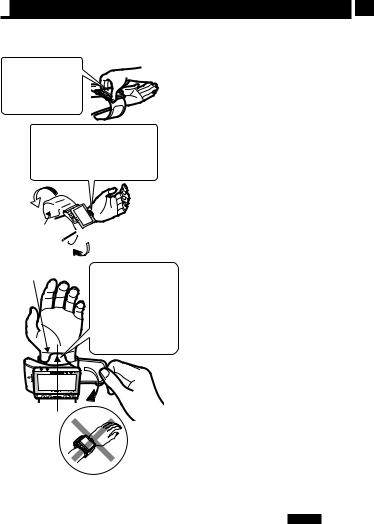

 Fitting the Pressure Cuff
Fitting the Pressure Cuff
Blood pressure is measured at your left wrist. It is not necessary to roll up
your sleeve or to remove any clothing.
Place the device on the inside of your wrist.
1.Place the device on the inside of your wrist.
•Place the device directly in contact with the skin.
•The device can be used by people with a wrist
Wrap the pressure cuff so that the positioning mark is aligned with the base of the wrist.
circumference of 5˝–8-3/4˝ (12.5–22.0 cm).
Fastener

 Fastener
Fastener
Base of the wrist
Wrap the pressure cuff so that the positioning mark will be at the center of the wrist.
2.Firmly wrap and fasten using the hoop and loop fastener.
•A loosely applied pressure cuff will result in high blood readings or incapable measurement.
•Press fastener softly to avoid the peel off.
English 12
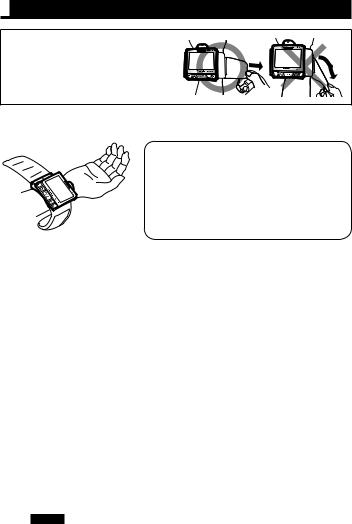

 Fitting the Pressure Cuff (cont.)
Fitting the Pressure Cuff (cont.)
Do not remove the hook-and-loop fastener by twisting it off.
Be sure to peel it in an horizontal direction in alignment with the cuff.
<When wrapping around right wrist>
Fit as shown in the figure.
The cuff can be used on either wrist. However, the difference in blood pressure between the left and right wrists may be around 10 mmHg, so be sure to always use the same wrist for measurements.
13 English
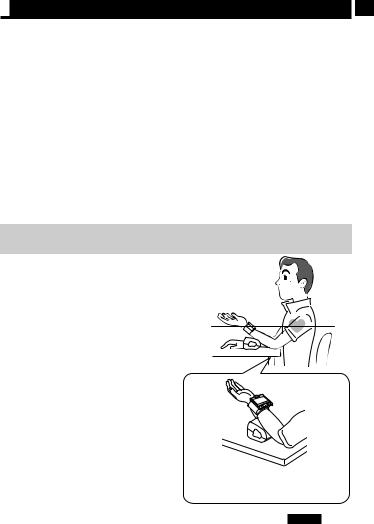

 Obtaining Accurate Measurements
Obtaining Accurate Measurements
Always take your blood pressure at the same time while sitting in the same position and using the same wrist.
It is recommended to check your blood pressure at least twice a day. It is best in the morning before breakfast and in the evening after work.
In the following situations, accurate measurements cannot be taken.
•Within 1 hour after eating or drinking alcohol
•Immediately after drinking coffee or tea, or smoking
•In a moving vehicle
•Immediately after exercising or taking a bath
(Wait at least 20 minutes and take a measurement while staying quiet.)
•In cold places
[Take measurements at room temperatures around 68 °F (20 °C).]
•When you need to urinate
(Wait several minutes after urinating before taking measurements.)
Always rest for four to five minutes before taking your blood pressure.
Taking measurements while sitting down
1. Place your elbow on the table.
2. Align the device with the level of
your heart.
3. Open and relax your hand with the palm facing up.
Please place your arm on top of the storage case once you have attached the pressure cuff.
English 14
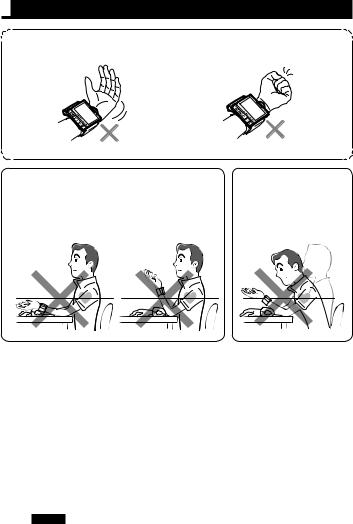

 Obtaining Accurate Measurements (cont.)
Obtaining Accurate Measurements (cont.)
Do not take measurements in the positions shown below as they will be inaccurate.
Do not bend your wrist inward. |
Do not clench your fist. |
If the device is placed at a height lower than the heart then the resulting readings may be higher than your actual blood pressure.
If the device is placed at a height higher than the heart then the resulting readings may be lower than your actual blood pressure.
If you lean forward while taking measurements then the resulting readings may not be accurate.
To obtain accurate readings, the following actions should also be avoided during measurements.
•Do not touch the device.
•Do not change position or move your wrist or fingers.
•Do not talk.
[CAUTION]
Keep away from cellular telephones and other sources of electromagnetic radiation during measurements.
Failure to do so could result in blood pressure monitor malfunctioning.
15 English
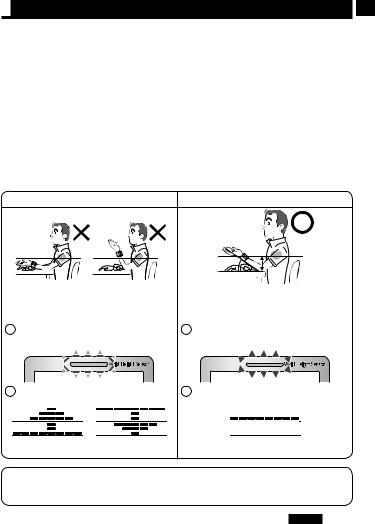

 Wrist Height Sensor
Wrist Height Sensor
About the wrist height sensor
•This is a support function to ensure that you use the blood pressure monitor at an appropriate height (same height as your heart). Users with a fixed measurement position and measurement environment (height
of table, height of chair, etc.) can achieve more stable measurement conditions by using this function.
•It will estimate the height of the blood pressure monitor wrapped around the wrist from the angle of the arm, and notify you of the appropriate measurement position with the wrist height sensor lamp.
(When a reading is saved, whether or not wrist height was appropriate at the time of measurement is also saved. This information is then indicated by the wrist height sensor lamp when recalling readings.)
When the height is not appropriate When the height is appropriate
|
Wrist is lower |
Wrist is higher |
|
Appropriate height |
|||
|
than heart |
than heart |
|
||||
|
|
(wrist is approximately at the height |
|||||
|
|
|
|
|
|||
|
|
|
|
|
|
of heart) |
|
1 |
Wrist height sensor lamp |
1 |
Wrist height sensor lamp |
||||
|
Flashes |
|
|
Is lit |
|||
2 |
Graph display |
|
2 |
Graph display |
|||
|
|
|
|
|
|
|
|
|
|
|
|
|
|
|
|
|
|
|
|
|
|
|
|
|
|
|
|
|
|
|
|
|
|
|
|
|
|
|
|
|
|
|
|
|
|
|
|
|
|
|
|
|
|
|
|
|
|
|
|
|
|
|
|
|
Upward arrow |
Downward arrow |
|
Displaying appropriate position |
|||
Wrist height sensor lamp will turn off a short period after the blood pressure measurement starts.
English 16
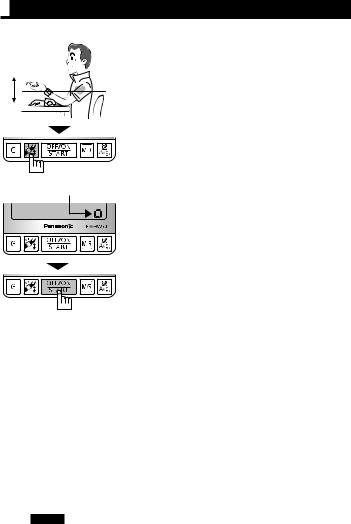

 Wrist Height Sensor (cont.)
Wrist Height Sensor (cont.)
Setting the Height
Height sensor setting display
1.Place the arm to which the device is attached on top of the storage case with the wrist positioned at the level of the heart.
2.Press the wrist height button for 3 seconds or longer.
It will notify by flashing the wrist height sensor lamp 3 times.
3.Press the Off/On Start button to turn off the unit.
•Once the height is set, the range of appropriate height (where the wrist height sensor lamp turns on) becomes narrow in comparison to when it is not set, making it easier to adjust to appropriate height.
17 English
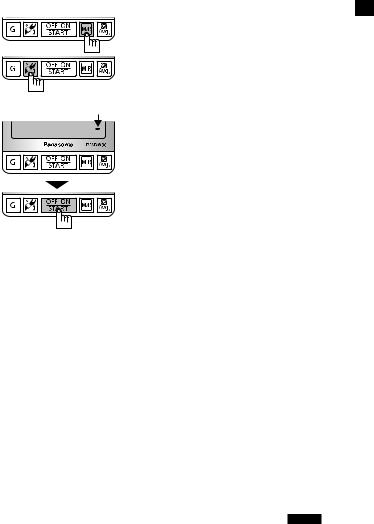
Clearing the Height Setting
1. Press the Memory/Recall button.
2. Press the wrist height button for
3 seconds or longer.
It will notify by flashing the wrist height
sensor lamp 3 times.
Height sensor off display
3. Press the Off/On Start button to turn off the unit.
English 18


 Measuring Your Blood Pressure
Measuring Your Blood Pressure
1. Place the arm to which the device is
attached on top of the storage case with
the wrist positioned at the level of the
heart.
(Please see “Obtaining Accurate Measurements” on pages 14 and 15.)
2. Press the wrist height button briefly.
• Wrist height sensor function will start. (For wrist height sensor, see pages 16 and 17.)
(Measurement will not start until the Off/On Start button is pressed.)
Note: Height setting is reset when it is pressed for 3 seconds or longer.
3. Fine adjust the arm angle.
• Fine adjust the angle of your arm so the wrist will be at the appropriate height.
• Wrist height sensor lamp will turn on when your wrist is at an appropriate height. (Please see pages 16 and 17.)
• Wrist height sensor lamp will turn off a short period while after the measurement starts.
You can also start measurement by proceeding to the step “4. Press the Off/On Start button.” without pressing the wrist height button. In such a case, both the blood pressure measurement and the wrist height sensor function will start simultaneously.
19 English
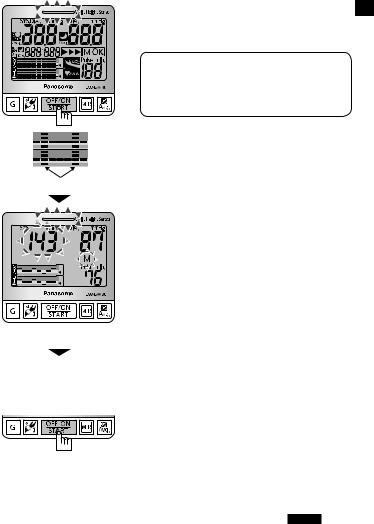
4. Press the Off/On Start button.
• The display will be lit up for approx. 2 seconds.
• The cuff will begin to inflate automatically.
As measurements are being taken during pressurization, operating sounds and the rate of pressurization may change. This is perfectly normal.
• The pulse detection mark will be displayed graphically during pressurization when the pulse is detected.
Pulse detection mark
5. When measurements have been completed, blood pressure and pulse rate are displayed.
• Pressure will automatically be released from the pressure cuff.
• If your blood pressure is considered to be in the hypertensive range, then the readings on the display will flash for approx. 6 seconds. (Please see page 21.)
• Measurement results are also displayed as graph. (Please see page 21.)
•The  mark will be flash.
mark will be flash.
(Please pages 26 and 27 for details regarding how to record readings.)
•The pulse is estimated over the period of a minute based on the pulse rate recorded when measurements were being taken.
6. Press the Off/On Start button to turn off the unit.
• If you forget to switch the device off, it will do so automatically after approx. 5 minutes.
English 20
